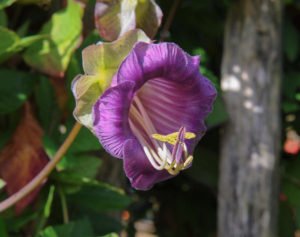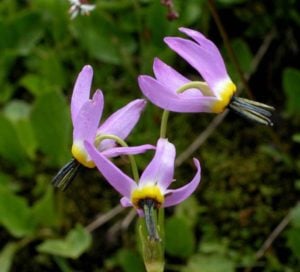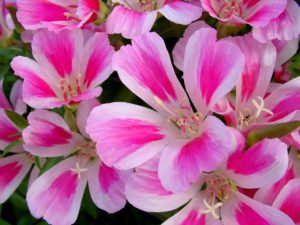
For as long as I can remember, Salvia grew up in our garden — first in my grandmother’s, then in my mother’s, and now in mine. Its charming and slightly intoxicating aroma enveloped him, filling the entire space around him, as if absorbing and conquering everything in its path. Love Salvia is not “born at first sight”, it’s like she lived in me always. In this article I want to share it with you, and talk about the subtleties and secrets of growing my favorite plants — Salvia.

The name Salvia, according to one version, comes from the Latin “salvare”, which means “to rescue”. And it’s true, Salvia-a real Savior, the healing properties of which mankind has known for centuries. Medicinal sage was grown in Roman Times, using this miraculous plant for the treatment of colds, throat diseases, toothache and much more.
According to another version, the name “Salvia” comes from the Latin “salvus”, which means “to be healthy”. And not in vain: in ancient times they said:”Salvia in the garden — you will not have a need for doctors.”

Depending on the species and variety, Salvia can grow in height from 30 cm to 1.5 m; stems tetrahedral, leaves pairwise opposite; flowers can be of different shapes and colors: red, purple, blue, yellow, purple, white or pink.
Planting of Salvia
Give General recommendations for the cultivation of Salvia is difficult, because this plant has many species that different from each other: some like the sun, the second — the shadow, the third — partial shade, some drought-resistant, others like moist soil and so on. But despite this, there are many similarities between the species of Salvia.
So, all cold-resistant Salvia feel equally good not only in partial shade, but also in the sun. Heat-loving species-on the contrary, can grow normally only in Sunny areas, they are not so demanding on soil moisture and more drought-resistant, keep this in mind during planting.

Choosing a place for planting Salvia, remember that all of them, regardless of the species, prefer to grow on light sandy soils, relatively rich in humus. And yet, I almost forgot, Salvia very easily interbreed with each other, which are not suitable for further multiplication of seed. Therefore, try to have different types of Salvia as far as possible from each other.
Reproduction of Salvia
Perennial species of Salvia are very simply propagated by semi-woody cuttings. And it can be carried out throughout the season. To do this, cut the Salvia cuttings with a length of about 15 cm, Rooted them in water containers, almost blind from the sunlight. Roots should appear after 14-16 days, and they can be planted literally a week after the roots.
More Salvia is very simply propagated by air layering: just press the branch of Salvia to the ground, securing it with a metal bracket, and in a few months on the twig will have new roots. Once the twig formed roots, it can be cut off from the main Bush and put in a new place.

All species of Salvia perfectly propagated by seeds. Towards the end of October, the seeds of Salvia sow in small beds, and forget about them until spring. In the spring of the young plants of Salvia are planted in a permanent place. You can sow the seeds of Salvia and in the spring-in early March. For this small capacity fill easy nutrient soil (universal potting mix for seedlings). As soon as the seedlings of Salvia get a couple of real leaves, transplant them into pots with a diameter of about 7 cm. Somewhere in the middle of April we begin to slowly temper the seedlings, for which we take them to the greenhouse. In the open ground, the strengthened seedlings can be planted only in early June-young plants of Salvia are very afraid of even very small cold weather.
Care for Salvia
Regardless of the species, Salvia can not tolerate stagnation of moisture in the soil — do not overdo it with watering. Growing Salvia as a perennial, get ready for the fact that the plant needs shaping scraps, thanks to which you can give it any desired shape. Pruning will not only help to form the desired shape of the Bush, but also will allow plants not to bare and not to stretch, stimulates mass growth of shoots, from which the Bush of Salvia will become even more beautiful and lush. Throughout the flowering season, try to remove the wilted flowers in a timely manner.

Needs Salvia in care and after flowering: at the end of the season, somewhere in October, arrange a good plant haircut, after which cover the Salvia layer of garden compost, generously falling asleep point of growth. Especially thermophilic varieties of perennial Salvia would be nice to additionally cover with dry leaves on top of compost.
Unfortunately, Salvia is one of those plants that can not always be stored in the flower garden, so in the autumn I dig out part of the rhizomes of thermophilic Salvia and hide them in the cellar, where they perfectly winter.
Types and varieties of Salvia
Genus Salvia, belonging to the family Lamiaceae, consists of a huge number of species — about 900, which is why it is considered one of the most common.

Salvia are different: shrubs, subshrub and herbaceous, annual, biennial and even perennial. I will tell you about the brightest representatives of the genus Salvia and start, perhaps, with cold-resistant.
Salvia officinalis
Salvia officinalis is an ornamental medicinal plant, semi-shrub or herbaceous, reaching a height of 70 cm.

Medicinal part of Salvia officinalis considered flowering tops and leaves of the plant.
Salvia sylvestris
Salvia sylvestris-cold-resistant ornamental plant, which in June blooms blue and purple flowers.

It was Salvia sylvestris that became the progenitor of many new hybrids and varieties, including:
- Schneehogel;
- Blauhugel;
- Rhapsody in Blue;
- Lye End and Rose Queen.
Salvia nemorosa
Salvia nemorosa is considered one of the most unpretentious cold-resistant members of the genus.

There are many varieties of Salvia nemorosa, the brightest of which are considered to be Rose Wine and Plumosa and Marcus and Caradonna.
Salvia pratensis
Salvia pratensis boasts beautiful white or rich blue-purple flowers (depending on the variety).

Flowering Salvia pratensis in late June-early July.
Salvia verticillata
Salvia verticillata is an exceptionally beautiful decorative cold-resistant plant with bright flowers lilac color.

Flowering Salvia verticillata lasts almost the whole summer-from early July until September.
Salvia transylvanica
Salvia transylvanica-one of the few types of cold-resistant Salvia, which grows well in partial shade.

Blooms Salvia transylvania from mid-June until the end of September, a beautiful lilac color flowers.
Salvia azurea
Pale blue Salvia azurea striking inflorescence of many small flowers.

Flowering begins in July and lasts until October, which makes this variety especially popular. In addition, among the varieties of Salvia azurea there is a large-flowered variety “Salvia azurea grandiflora”.
Salvia uliginosa
Native to South America, Salvia uliginosa is a relatively thermophilic giant plant, reaching 2 m in height.

It is Salvia uliginosa that I consider one of the most beautiful representatives of the species: small (about 7 cm) elongated leaves carved on the edge, and bright blue-blue flowers that bloom from August to October.
Well, about the most famous cold-resistant varietys of Salvia, I told you in detail. Now let’s talk about Salvia thermophilic.
Salvia splendens
Salvia splendens is very popular with gardeners. It is a perennial cultivated in the middle zone as an annual, affecting the flowers of rich (from bright orange to red-purple) color.

Flowering Salvia splendens begins early enough-in June, and continues until cold weather.
Salvia coccinea
Salvia coccinea-biennial, loving heat and moisture, which will thank you for frequent watering unusually lush flowering, beginning in August and lasting until cold.

Blooms beautiful red, pink or white flowers.
Salvia microphylla
Salvia microphylla-thermophilic subshrub, which is considered the birthplace of Mexico. Since mid-summer blooms many bright red, yellow, red-white or purple flowers that delight the eye before the cold.

But the amazing Salvia microphylla is not so much its bright outfit as small oval leaves of light green color: if you crumple them in your hand, you will feel the pleasant aroma of black currant!
Salvia sclarea
Salvia sclarea is a perennial or biennial plant, reaching a meter in height. Large round-oval leaves are very fragrant, and its flowers are striking in a variety of colors, from pink and blue to cream-purple hue.

Salvia sclarea is one of the few species of Salvia that breeds by self-seeding.
Salvia regla
Native of Texas-Salvia regla, thermophilic subshrub that grows in width more than in height. Individual copies of Salvia regla in width can reach a meter or more!

Blossoms Salvia regla beautiful red flowers from late August to mid-October.
Salvia elegans
Salvia elegans absolutely corresponds to its name: its tall (about 1 m) slender stems strewn with beautiful bright red flowers funnel-shaped.

The leaves of Salvia slender also surprise with its unusual smell-they exude a delicate fruity aroma. For example, the leaves of Salvia varieties Tangerine Sage, if they rub in the palms, smell of tangerine, and the leaves of the variety Scarlet Pineapple — Pineapple.



